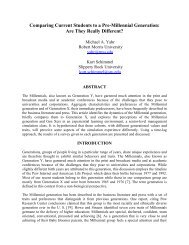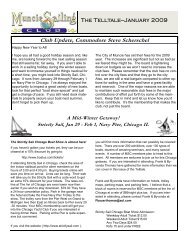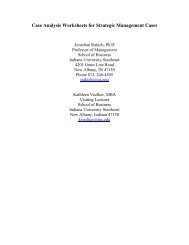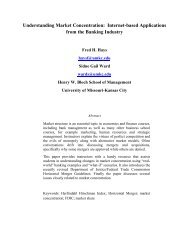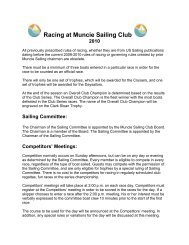The Balanced Scorecard with Time-Driven Activity Based-Costing ...
The Balanced Scorecard with Time-Driven Activity Based-Costing ...
The Balanced Scorecard with Time-Driven Activity Based-Costing ...
Create successful ePaper yourself
Turn your PDF publications into a flip-book with our unique Google optimized e-Paper software.
low volume or labor intensity is mixed <strong>with</strong> automation or new technology. For instance, the<br />
more low-volume products or services offered, the more set-up-related overheads are incurred.<br />
<strong>The</strong> activity hierarchy provides explicit recognition of the type of activities and costs that are<br />
expected to be influenced by changes in production or service volume or mix [11]. A good cost<br />
system systematically analyzes a majority of all costs incurred by a significant unit of business<br />
[8] and helps management understand what resources are consumed and what outputs are<br />
produced by each activity and process <strong>with</strong>in the organization, enabling better decision-making<br />
[18].<br />
Over the past decades, recessionary environments have given birth to cost reduction<br />
programs that actually resulted in several million US managers and workers having to accept pay<br />
cuts or lose their jobs. <strong>The</strong> downsizing trend has increased over the last five years because of<br />
extreme pressures brought on by a changing economy and intense global competition. <strong>The</strong>se cost<br />
reduction programs only provided short-term cost competitiveness because valuable, trained<br />
managers and workers lost their jobs. Many US firms failed to adopt a long-term perspective for<br />
a strategic business plan. Current reports indicate that the necessary cost reductions have not<br />
been achieved through the downsizing. This sets the stage for potential long-term failure [31].<br />
During this period, many organizations have revised their cost systems significantly as they<br />
have reorganized to become more competitive in an environment that demands high quality,<br />
excellent service, and reasonable prices. Customers’ expectations are higher as a result of<br />
unprecedented scientific and technological progress. This along <strong>with</strong> the intense global<br />
competition will cause new management philosophies and policies, such as hospital partnerships,<br />
to be essential factor in meeting these changing demands [5].<br />
Profit contribution by market segmentation was discussed and written about in 1970s. <strong>The</strong><br />
contribution approach emphasized the classification of costs by behavior patterns and logical<br />
attachability to cost objects as opposed to some arbitrary allocations. <strong>The</strong> merits of the<br />
contribution approach for decision-making have been illustrated over time <strong>with</strong> many<br />
documented examples. Contribution analysis is necessary to determine profit contribution by<br />
product, service line, or by patient. <strong>The</strong> per unit or service contribution margin can be obtained<br />
by subtracting unit or service-level costs from unit or service price. A product or service-level<br />
margin can be obtained by subtracting unit or service-level, batch-level, and product or servicelevel<br />
costs from total product revenue [11].<br />
Management accountants must use new accounting techniques, such as the balanced<br />
scorecard, time-driven activity-based costing, and contribution approach or incremental profit<br />
analysis, to determine conditional profit. <strong>The</strong>y also must combine accounting techniques <strong>with</strong><br />
probabilities, so they can provide unique and practical decision rules to be applied to special<br />
decision problems.<br />
INCREMENTAL APPROACH THEORY<br />
<strong>The</strong> essence of this proposed model considers profit contribution and incremental cost analysis<br />
given certain decisions including probabilities. <strong>The</strong> theoretical probabilities for sales volume are<br />
used to illustrate how probabilities of customer behavior can be considered for alternative<br />
decision-making.<br />
<strong>The</strong> model can be used to determine the optimal course of action for profit maximization.<br />
Given certain operating changes, managers are interested in identifying the optimal course of



